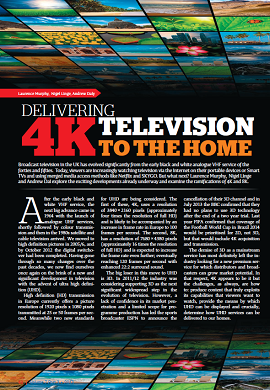Delivering 4K Television to your home

This paper was published in 2013 within the Journal of the Institute of Telecommunications Professionals (Volume 7, Part 3, Pages 40-44) and is made available here with their kind permission.

Introduction
Broadcast television in the UK has evolved significantly from the early black and white analogue VHF service of the forties and fifties. Analogue UHF services were launched in 1964, shortly followed by colour transmission and then in the 1980s satellite and cable television arrived. We moved to high definition pictures in 2005/6 and by October 2012, the digital switchover had been completed. Today viewers are increasingly watching television via the Internet on their portable devices or Smart TVs and using merged media access methods like Netflix and SKYGO.
Having gone through all of these changes, we now find ourselves once again on the brink of a new and significant development in television with the advent of ultra high definition (UHD). High definition (HD) transmission in Europe currently offers a picture resolution of 1920 pixels x 1080 pixels transmitted at 25 or 50 frames per second. Meanwhile two new standards for ultra-HD (UHD) are being considered. The first of these, 4K, uses a resolution of 3840×2160 pixels (approximately four times the resolution of full HD) and is likely to be accompanied by an increase in frame rate in Europe to 100 frames per second. The second, 8K, has a resolution of 7680×4380 pixels (approximately sixteen times the resolution of full HD) and is expected to increase the frame rate even further; eventually reaching 120 frames per second with enhanced 22:2 surround sound.
The big loser in this move to UHD is 3D. In 2011/12 the industry was considering supporting 3D as the next significant widespread step in the evolution of television. However, a lack of confidence in its market penetration and a limited scope for programme production has led the sports broadcaster ESPN to announce the cancellation of their 3D Channel and in July 2013 the BBC confirmed that they had no plans to use 3D technology after the end of a two year trial. Last year FIFA confirmed that coverage of Brazil 2014 would be prioritised for 2D, not 3D, but that would include 4K acquisition and transmission.
The demise of 3D as a mainstream service has most definitely left the industry looking for a new premium service for which distributors and broadcasters can grow market potential. In that respect, 4K appears to be it but the challenges, as always, are how to: produce content that truly exploits its capabilities that viewers want to watch, provide the means by which UHD can be displayed and crucially, determine how UHD services can be delivered to your home.


Follow on social media .....